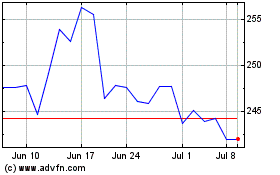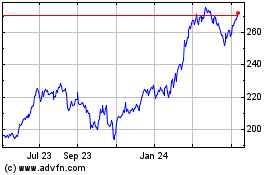US Industry Groups Urge Multi-Year Highway-Spending Bill
November 18 2009 - 6:14PM
Dow Jones News
A consortium of asphalt and concrete industry groups are urging
Congress to pass a new transportation bill soon because states
won't commit to highway construction without a long-term federal
spending plan.
In a letter sent to federal lawmakers Wednesday, the consortium
asked Congress to enact a new, six-year highway-spending bill
instead of extending for a second time the previous one that
initially expired at the end of September. Congress extended the
previous bill to the end of the year.
"The current lack of funding certainty in the federal highway
market is having a devastating effect on the transportation
construction industry," wrote the consortium, which include the
National Asphalt Pavement Association, or NAPA, the American
Concrete Pavement Association, the National Ready Mixed Concrete
Association, the National Stone, Sand & Gravel Association and
the Portland Cement Association.
The vast majority of U.S. roads are made out of asphalt, and
production of the road material is expected to be down 15% this
year. Producing liquid asphalt is a small business for even the
small independent refiners, but it has been a profitable niche at a
time when most refiners are posting quarterly earnings losses.
NuStar Energy (NS) Chief Executive Curt Anastasio said he is
"more bullish on demand going into 2010" for the company's two East
Coast asphalt refineries based on the stimulus money and tighter
supply of asphalt. But Anastasio and other asphalt producers say a
sustained recovery will depend on a multi-year highway bill.
Congress has no solid transportation plan to replace the
previous bill; both houses of Congress only have proposals to
extend the old one.
The House of Representatives has proposed a three-month
extension while a bipartisan group of seven senators on the Senate
Environment & Public Works Committee sent a letter Tuesday to
the committee's leadership to extend it by six months.
The Senate committee held a briefing on Wednesday with
Department of Transportation officials that revealed states are
receiving 30% less highway funding than last year, said Jay Hansen,
vice president of NAPA's government affairs.
Senator Barbara Boxer (D., Calif.), who supports the six-month
extension, also called on the Obama Administration to submit a
highway plan with a way to pay for it.
Hansen said NAPA would support a six-month plan if the time is
used to write and pass a comprehensive bill: "States are paralyzed;
[they] can't take projects to the next level without knowing where
the money would come from."
The floodgates for federal stimulus spending on highway projects
are expected to open in 2010, but that represents just a fraction
of the billions more states need for new roads and repairs, Hansen
said.
Out of the $787 billion stimulus package Congress passed early
this year, $27.5 billion was earmarked for highway and bridge
construction. Roughly 10%-15% of that money will be awarded by the
end of 2009.
The stimulus program "is fairly short lived, it's a finite
amount of money," said Neal Hickerson, spokesman for Holly Corp.
(HOC), which earns about a fifth of its revenue from liquid
asphalt. In recent weeks, construction firms Vulcan Materials Inc.
(VMC) and Granite Construction Inc. (GV), among others, were
pessimistic about their near-term prospects during their earnings
conference calls.
Road construction accounts for 85% of the asphalt demand in the
U.S., with the rest coming from roofing. Almost two-thirds of the
funding is driven by federal, state and local governments, with the
rest coming from the private sector.
In the long run, there is a great deal of pent-up demand for
building roads, but the near-term emphasis is going to be on
performing maintenance rather than big projects because of budget
constraints, said William L. Thorpe, senior vice president of Alon
USA Energy Inc.'s (ALJ) asphalt division.
For instance, California, which has been struggling with budget
shortfalls, estimated that more than a third of its roads are in
poor condition and need $6 billion for repairs, Thorpe said.
California was allocated less than half that amount under the
stimulus package. Thorpe doesn't expect trends to improve until
late next year.
-By Naureen S. Malik, Dow Jones Newswires; 212-416-4210;
naureen.malik@dowjones.com
Vulcan Materials (NYSE:VMC)
Historical Stock Chart
From Mar 2024 to Apr 2024

Vulcan Materials (NYSE:VMC)
Historical Stock Chart
From Apr 2023 to Apr 2024
